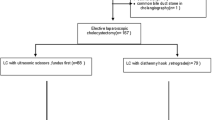Background: Laparoscopic cholecystectomy (LC) is the gold standard treatment of gallstones. Nevertheless, there are some pitfalls due to the limits of current technology and the use of inappropriate ligature material, with a relevant risk of injuries and postoperative, mainly biliary, complications. Ultrasonically activated scissors may divide both vessels and cystic duct, with no need of further ligature, and possibly reduce the risk of thermal injuries. Methods: A prospective nonrandomized clinical trial was started in 1999 to test harmonic shears (Ultracision, Ethicon Endo-Surgery, Cincinnati, OH, USA) in 461 consecutive patients undergoing LC in order to evaluate the theoretical benefits of ultrasonic dissection and the possible reduction in intraoperative bile duct injuries (BDIs) and postoperative complications. Patients were divided in two groups: in group 1 (HS; 331 patients) the operation was performed by Ultracision (including coagulation–division of cystic duct and artery); in group 2 (LOOP; 130 patients) the cystic duct, after coagulation–division by harmonic scissors, was further secured with an endo-loop. Both groups were further divided into two subgroups: expert and surgeon-in-training. The following categories of data were collected and analyzed: individual patient data, indication for laparoscopic cholecystectomy, surgical procedure data (associated procedures, intraoperative cholangiography, intraoperative complications, length of surgery, and conversion to open), and postoperative course data (postoperative morbidity, postoperative mortality, reinterventions, and postoperative hospital stay). Furthermore, biliary complications were analyzed as a single parameter comparing the incidence within groups and subgroups. Cumulative complications (intraoperative and postoperative) were also analyzed as a single parameter comparing their incidence in the series of each surgeon within the surgeon-in-training subgroup to the average results of the expert subgroup. Finally, length of surgery, postoperative complication rate, and length of postoperative hospital stay within subgroups were analyzed to evaluate the learning curve. Results: Overall conversion rate was 0.87%. The mean operating time was 76.8 min (median, 70 min) in group 1 and 97.5 min (median 90 min) in group 2. BDI occurred in 1 case (0.32%) in the surgeon-in-training subgroup. Overall BDI rate was 0.22% (1/461). The overall incidence of postoperative bile leak was 2.7% (9 patients of subgroup 1 and 1 patient of subgroup 2). Clinical observation with spontaneous resolution occurred in 4 patients, and in 1 case the management consisted in an endoscopic biliary drainage; surgery was requested in the remaining cases. A laparoscopic approach was successfully attempted in all cases. Overall morbidity rate was 8.76% in group 1 and 13.84% in group 2. Rates of major complications, overall biliary complication, and postoperative bile leaks within the expert and surgeon-in-training subgroup differ significantly (p = 0.026, p = 0.03, and p = 0.049, respectively). There was 1 death (0.22%) due to sepsis that resulted from a small bowel injury by trocar insertion. Mean postoperative stay was 4.28 days for group 1 and 5.05 days for group 2. Conclusion: No significant difference was found in both patient groups regarding postoperative mortality and complications, biliary complications, and especially cystic duct leaks. A retrospective comparison of literature data showed that use of ultrasonic dissection during LC seems to reduce the risk of BDI. Nevertheless, a learning curve in the use of ultrasonic-activated devices is required: a significant differences in postoperative major complications and biliary complications between the expert and the surgeon-in-training subgroups was shown. Furthermore, ultrasonic scissors misuse may cause bowel injuries in patients with severe adhesions, and this could represent a possible limitation for surgical safety.
Similar content being viewed by others
Author information
Authors and Affiliations
Rights and permissions
About this article
Cite this article
Hüscher, C., Lirici, M., Di Paola, M. et al. Laparoscopic cholecystectomy by ultrasonic dissection without cystic duct and artery ligature . Surg Endosc 17, 442–451 (2003). https://doi.org/10.1007/s00464-002-9068-3
Received:
Accepted:
Issue Date:
DOI: https://doi.org/10.1007/s00464-002-9068-3




